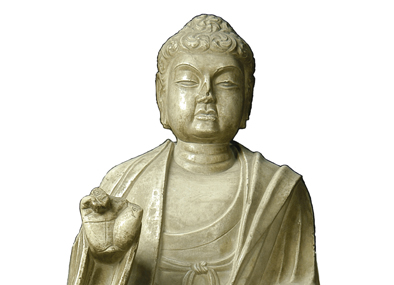Cloth-sack Monk and “Laughing Buddha with a Potbelly”
The image of that laughing monk with a potbelly in the Hall of Heavenly Kings in a temple comes to people’s mind when one talks about Maitreya Buddha. Who was this monk indeed? Known as the Cloth-sack Monk, this monk, according to The Memories of Eminent Monks of the Song Dynasty and A Comprehensive Records of the History of Buddhism, was called Qici or Changtingzi and he was a famous monk in Jiangsu and Zhejiang areas during the Five Dynasties. His prophecies turned to be accurate, despite his nonsense-like words. This monk could give accurate weather forecast and never got wet in snow. People were surprised at him. In 916 (the second year of the Zhenming era of the Later Liang regime during the Five Dynasties), Qici sat on a huge rock in Yuelin Temple, Mingzhou, and chanted a poem, reading “True Maitreya Buddha has innumerable incarnations. People never recognize him in disguise”. Then he entered nirvana. People thought the monk to be Maitreya’s incarnation, because of his weird behaviors and the hymn. In addition, he had been kind-looking and always at ease when he was alive. People in Jiangsu and Zhejiang areas began in the Song Dynasty to sculpt statues of Maitreya into the image of the Cloth-sack Monk and place such a statue in the Hall of Heavenly Kings in a temple, so that visitors could feel happy upon entering the temple. The image of this laughing monk with a potbelly well reflected Chinese people’s optimism and tolerance, as well as benevolence, generosity, peace and equality pursued in Buddhism. Since then, almost all the halls of Heavenly Kings in Buddhist temples in the Han chinese-inhabited areas in China had the Cloth-sack Monk as the main statue. The image of Laughing Buddha with a Potbelly was popular with people. Furthermore, Chinese emperors in later generations also approved this change. Emperor Zhenzong of Song conferred a horizontal inscribed tablet of “Dazhong Yuelin Chansi” on Yuelin Temple and Emperor Renzong of Song conferred the title of “Master Dingying” on the Cloth-sack Monk.
What was Tushita Heaven like in Buddhist scriptures? What did the human world look like after Maitreya descended into it and attained Buddhahood here?
Your answer please, if you have any questions or answer, please feel free to send us email, we are waiting for your answers and participation, and your comments, answers and suggestions will be highly appreciated. We will select and publicize the most appropriate answers and comments some time in the future.
Weekly Selection Email: meizhouyipin@chnmus.net
The creation of Maitreya statues began to thrive in the Northern Wei Dynasty and kept its momentum till the Sui and Tang dynasties. As shown by the statues of Maitreya in Henan Province, there were four stages in the development of Maitreya statues in China. A Maitreya statue in early days was usually presented through the image of a cross-legged Bodhisattva, depicting Maitreya Bodhisattva expounding on Buddhist scriptures in Tushita Heaven. The earliest image of Maitreya so far in existence in China was found in the mural in No.169 Cave of the grottoes in Bingling Temple, Gansu Province, initially excavated during the Western Qin regime of the Sixteen Kingdoms. Next to the image there was an inscription in ink, reading “Maitreya Bodhisattva”. The caves in the Qizil Grottoes in Xinjiang and the Mogao caves excavated during the Northern Liang regime of the Sixteen Kingdoms largely had Maitreya as the main statue. The statue of cross-legged Maitreya Bodhisattva dominated the Yungang caves excavated before Emperor Xiaowen of the Northern Wei relocated his capital city to Luoyang, as well as the Guyang Cave excavated during the Northern Wei Dynasty in the Longmen Grottoes. Such Maitreya statue was clad in Bodhisattva’s costume and sat cross-legged in a house-like niche, representing the scene that Maitreya expounded on Buddhist scriptures in Tushita Heaven. (Fig.2) A Maitreya statue created during the Northern Qi regime usually had on his head a crown and sat on a base, clad in Bodhisattva’s costume, illustrating the image of Maitreya in the human world before attaining Buddhahood. (Fig.3) A Maitreya statue began to be changed to seated one clad in Buddha’s costume in the Tang Dynasty, depicting the image of Maitreya attining Buddhahood under the Nagapuspa Tree (Fig.4). From the Song Dynasty, Monk Qici was thought to be the incarnation of Maitreya, thanks to the hymn the monk had chanted before his nirvana. From then on, a Maitreya statue took on the image of that commonly-seen laughing monk with a potbelly. (Fig.5)
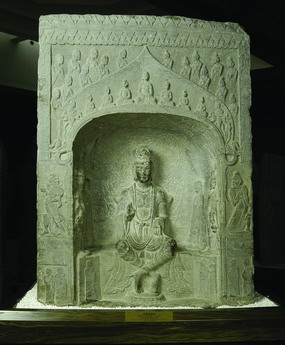
Fig.2 Daohan statue stele, Northern Wei
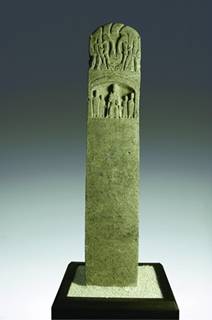
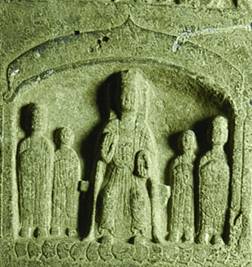
Fig.3 Statue stele by Chen Guang (whole and part), Northern Qi
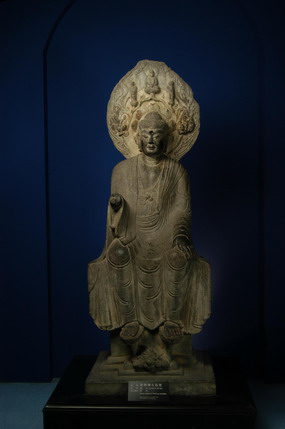
Fig.4 Statue of Maitreya of the Tang Dynasty, Beigang, Zhengzhou
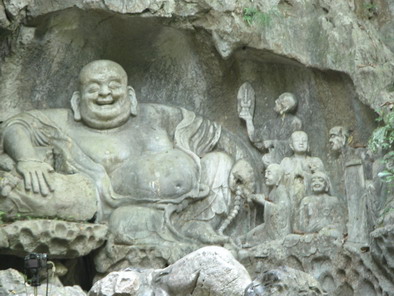
Fig.5 Statue of Laughing Buddha
Maitreya, a Bodhisattva of Loving Kindness, was named Ajita. According to Sutra of Maitreya’s Ascension and Maitreya-vyakarana Sutra, born into a Brahman family, Maitreya became Śākyamuni’s disciple and entered nirvana before Buddha. He then resided in Tushita Heaven and descended to the human world 5.67 billion years after Śākyamuni’s nirvana. Maitreya Bodhisattva attained Buddhahood and became Maitreya Buddha under the Nagapuspa Tree in a garden named Hualin in Chinese, delivering all living creatures from torment. Belief in Maitreya was popular in China as early as in the Western Jin and Eastern Jin dynasties. By the time of the Sixteen Kingdoms, all the major Maitreya scriptures had been translated into Chinese, in as many as 10-plus versions, including Sutra of Maitreya’s Descending and Sutra of the Past Vows of Maitreya Bodhisattva translated by Dharmarakṣa in 303 (the second year of the Tai’an era of the Western Jin Dynasty); Sutra of Maitreya Bodhisattva’s Attainment of Buddhahood and Maitreya-vyakarana Sutra translated by Kumārajīva in 402 (the fourth year of the Hongshi era of the Later Qin Dynasty); Sutra of Maitreya’s Ascension translated by Juqu Jingsheng (?-464) of the Song regime during the Southern Dynasties; Sutra of Maitreya’s Coming translated by anonymous author(s) in the Eastern Jin Dynasty; and Maitreya Pariprichcha translated by Bodhiruci from 508 (the first year of the Yongping era of the Northern Wei Dynasty) to 535 (the second year of the Tianping era of the Eastern Wei Dynasty). With Amitabha Sutra translated into Chinese in the Tang Dynasty, more and more Buddhists were determined to go to the Pure Land after their deaths. Therefore, Amitabha Buddha attracted more followers than Maitreya Buddha did. Nonetheless, belief in Maitreya Buddha has never disappeared. Its influence lasted into modern China.
There were two sects of Maitreya belief in China, namely, the sect believing in Maitreya’s ascension and the sect believing in Maitreya’s descending. The former believed that Maitreya Bodhisattva entered nirvana and resided in Tushita Heaven. The latter believed that Maitreya descended into the human world and attained Buddhahood under the Nagapuspa Tree. Delivering all living creatures from torment by preaching Buddhist scriptures to them, Maitreya Bodhisattva himself also attained Buddhahood. Buddhist monk Dao’an (312-385) was a representative of the sect believing in Maitreya’s ascension. According to Biography of Dao’an in the fifth volume of The Memories of Eminent Monks of the Liang Regime, Fu Jian of the Former Qin regime sent envoys to the Western Regions. They brought back a statue of Maitreya. Dao’an always placed this statue on his desk when he held a lecture on Buddhist scriptures. According to the 16th volume of Pearl Forest in Buddhist Garden, Dai Yong of the Eastern Jin Dynasty had a statue of Maitreya sculpted by following the instructions he had had in a dream. Dai placed this statue in Longhua Temple in Kuaiji. As described in The Transcript of the Memories of Eminent Monks, Faxiang built a Maitreya vihara in 432 (the ninth year of the Yuanjia era of the Song regime during the Southern Dynasties). The renowned believers in Maitreya’s ascension also included Daojiao, Sengye, Huiyan, Daowang, Daofa, Fasheng, Tanfu and Tanbin. Xuanzang and Kuiji of the Tang Dynasty also carried forward the belief in Maitreya’s ascension that became a sublime belief of the Yogācāra School. However, the belief in Maitreya’s descending was also popular in China. According to The Preface to the Catalogue of the Origins of Buddhist Scriptures in the 12th volume of Catalogue of Tripitaka Works Translated into Chinese, Emperor Ming of Song during the Southern Dynasties wrote Vows under the Nagapuspa Tree, Zhou Yong wrote On the Belief in Maitreya’s Descending around the Capital Area and King Wenxuan of Qi during the Southern Dynasties wrote Notes on Maitreya’s Lecture under the Nagapuspa Tree. Monk Huisi, Master of the Southern Sacred Mountain, expounded on the belief in Maitreya’s descending in My Vows. Wu Zetian, the only woman-emperor in China’s history, made full use of Buddhist thoughts to legitimize her behaviors that went against traditional Chinese ethics. Xue Huaiyi and others fabricated Mahamegha Sutra, claiming that Wu Zetian or Empress Wu was an incarnation of Maitreya. This gave religious legitimacy to Wu as the first woman-emperor in Chinese history. Ascending the throne, Empress Wu titled herself in 695 (the first year of the Zhengsheng era) as “Maitreya-incarnated Emperor of Golden Wheel”, claiming herself to be Maitreya. During her reign, China saw a climax of grotto excavation and Buddhist statue creation unrivaled in history. Empress Wu tried to consolidate her reign with the Maitreya belief. This religious faith was used as a ruling method in the human world with a completely utilitarian purpose. The ruling class tried to keep the social, political and economic order, by diverting with the Maitreya belief the believers’ attention from reality to Maitreya’s Pure Land.
The white marble statue of Maitreya features an ushnisha on the crown. Three clockwise spirals are engraved above the hairline and on the ushnisha, arranged in a triangular shape. The Buddha has a plump face with mild features typical of Han Chinese people. There are three lines on his neck. Inside the gown-like kasaya is a piece of shoulder-covering Sankaksika cloth, with a belt knotted at the breast. The kasaya wraps over his right rib and left arm and droops over in front of the right shoulder, covering the right arm. The pleated gown droops over the Buddha’s feet. His left hand is placed on the left knee in a natural way and his right hand held in front of the body, with the elbow bent and the palm to the front in Dharmacakra mudrā (lecturing gesture). Some fingers are damaged, though. The Buddha sits on a square base, his feet on two lotus flowers in full blossom. On each of the four corners of the narrow-waist square Xumizuo pedestal underneath the base there is a yaksha holding the base. In the middle of each side is a beast’s head. The statue is almost intact, except for the damaged fingers.
Fig.1 The upper part of the statue of Maitreya
The statue shows a typical Tang style, despite no exact date found on it. It has features of the Buddhist statues made during the Tang Dynasty in the Longmen Grottoes, namely, the three clockwise spirals and the gown-like kasaya. The pleats look smooth with concave round sculpture, instead of the straight lines previously used. The statue looks more lifelike, thanks to the bas-relief, high relief and openwork techniques adopted. It was undoubtedly a statue of the Tang Dynasty.
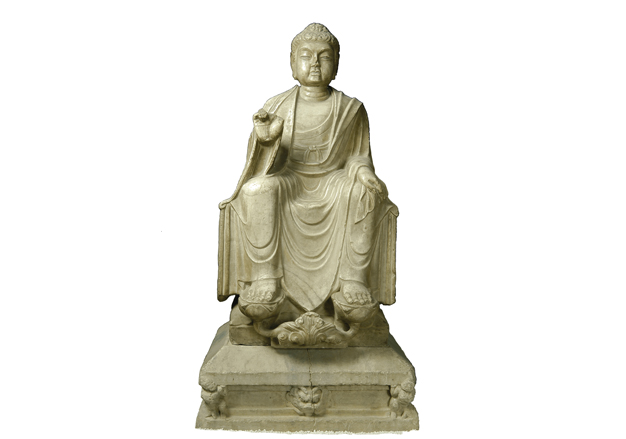

Mr. Wang Jingquan, vice director and researcher of the Exhibition Department of Henan Museum.Devoted to the research on the archaeology and art of Buddhism,he has made an impressive achievement by publishing over 10 monographs and 20+ academic papers on the core journals in China.
